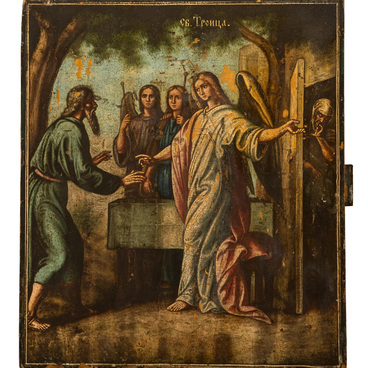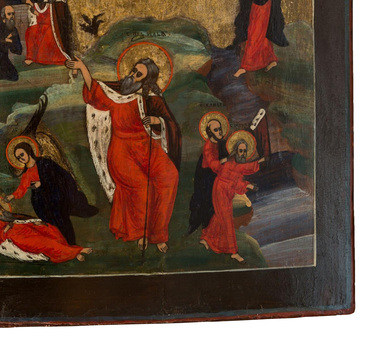In the olden days, such images were called “chernushki” — black icons — because of the predominance of black color. However, the main color of this image was white — the color of the cloth. On top of the white cloth, the face of the Savior is painted with a minimum number of layers: sankir — the base layer — is made with dark shades of ocher, on which dense white lines are applied. The border of dark and white colors is softened by lines of lighter ocher. The whitewash is used only in certain areas. Sankir uncovered by white paint sculpts the features of the face — eyebrows, eyes, lips, and a chin dimple. This allowed the master to make the face look graphically rigid, yet highly expressive.
From the image, the Lord looks at the viewer thoughtfully, attentively. The painter depicted the upper corners of the cloth twisted — they symbolize the knots with which the cloth was attached to nails driven into the wall of the church.
The original Savior Not Made by Hands is the first ancient image of Jesus Christ: Eastern written sources mention it since at least the 4th century. According to them, the ruler of the city of Edessa, Abgar, who was suffering from a serious illness, sent a messenger to Jesus Christ, asking to heal him. In response, Christ sent to Abgar His Image Not Made by Hands on a linen cloth (ubrus). After the Ascension of Jesus, Thaddeus the Apostle (also known as Jude) came to Edessa, healed Abgar and led the inhabitants of the city to faith. The miraculous image remained the main shrine of Edessa for many centuries.
In the 8th century, with the beginning of the iconoclastic persecutions unleashed by Leo III the Isaurian, Pope Gregory II and the Seventh Ecumenical Council cited the existence of the Image Not Made by Hands as the most important evidence in favor of the veneration of icons.
In 944, the army of the Roman Empire besieged Edessa; the inhabitants of the city asked for peace, offering the sacred image in exchange. In the same year, the Image Not Made by Hands was solemnly transferred to Constantinople, where it was kept for 260 years.
In 1204, the icon was taken by the crusaders who
captured the city. The ship carrying it to the West was wrecked, and the image
was lost. But long before the beginning of the 13th century,
numerous copies of the Savior Not Made by Hands were distributed throughout the
Orthodox world.


